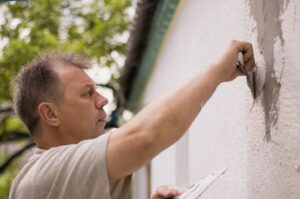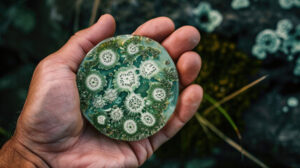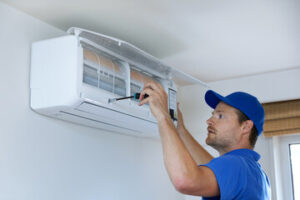Stucco is a durable material that adds style and texture to the exterior of your home. It’s also a great way to protect your home from moisture damage.

Stucco Contractors Philadelphia PA can ensure that your project is done right. They have the experience and expertise to handle any problems that may arise during the repair process.
Stucco contractors who have extensive experience working with the material are better able to handle the nuances of the project and achieve quality results. They also know how to identify issues early on and address them promptly, which can save time and money. Homeowners can evaluate a stucco contractor’s experience by asking about previous projects and reviewing their online reviews. They should also ask the contractor about their licenses and insurance, which can help ensure they follow industry standards and are covered for any damages during the project.
In addition to evaluating a stucco contractor’s experience, homeowners should compare quotes from several providers. Price should be a factor in the decision-making process, but it shouldn’t be the only consideration. Look for a competitive quote that includes a detailed breakdown of costs and details about the materials to be used. Also, ask about any additional charges or fees that may be added during the project and how they will be paid.
Reputable stucco contractors will stand behind their work and offer warranties that protect your investment. These warranties typically cover both materials and workmanship, ensuring that any issues that arise during or after the project are addressed without cost to you. They will also provide a clear explanation of their warranty policies so that you can understand the specifics and decide whether or not the warranty is right for you.
A well-established stucco contractor will be able to provide references and a portfolio of previous work that showcases their capabilities. They will also have the ability to discuss your project and provide an estimate based on its scope and complexity. They will also be able to provide you with information about the different types of finishes and their benefits, including durability and energy efficiency.
Stucco is a versatile material that can be used on a variety of surfaces, including concrete, cinder block, clay, and wood frame. It is durable, fungus resistant, and easy to maintain, which makes it an excellent choice for residential and commercial applications. Additionally, it is available in a wide range of colors, which means you can find the perfect shade to match your home or business.
Expertise
Stucco contractors have years of experience mixing, repairing, and applying stucco. Their expertise enables them to quickly identify the most appropriate solution for your unique project, whether it’s a full replacement or repair. They also understand how local weather conditions impact stucco application and curing, ensuring the work will last longer. Choosing a reputable contractor ensures quality results that you can count on.
Hiring a professional saves you time and money. Unlike DIY applications, which can take days to complete, professionals can finish the job in a fraction of the time. Furthermore, they use the right tools and materials to create an attractive, long-lasting result. Professionals are also familiar with building codes and regulations, preventing costly mistakes that would result from a DIY approach.
A reputable contractor will provide references and a detailed portfolio of previous projects. This will help you gauge their skills and aesthetic, ensuring that they match your vision for the project. Moreover, they will be willing to answer any questions you may have about their work process and pricing. Lastly, they should be bonded and insured, providing financial protection in case of any unexpected issues during the project.
When evaluating potential stucco contractors, it’s important to compare their quotes carefully. Look for a breakdown of costs and materials to avoid hidden fees. Likewise, avoid contractors who offer unusually low bids without explaining why. This could indicate subpar materials or a lack of experience.
The best stucco contractors stay up-to-date with industry trends and innovations, enabling them to handle a variety of different projects. They are also open to feedback and adjustments, ensuring that the final product meets your expectations. Finally, a dependable stucco contractor will maintain effective communication with you throughout the project.
Finding a reputable stucco contractor isn’t difficult, but you must do your homework before making a decision. Ask friends and neighbors for recommendations, and check online reviews to find out more about their experiences with different contractors. Once you’ve narrowed down your options, request written estimates from the most promising candidates. Compare the quotes to identify a contractor who is both affordable and experienced.
Portfolio
When choosing a stucco contractor, it is important to find one who has a wide variety of projects to show for their work. This allows you to see the contractor’s skill set and whether their aesthetic aligns with your vision for your property. Additionally, a reputable stucco contractor will have customer reviews and testimonials available to give you an idea of the quality of their work.
Stucco is a versatile, durable building material that has been used to adorn structures for centuries. Made of a mixture of lime, cement, and sand, this timeless finish adds beauty to any home or office while providing protection from the elements. Whether you’re looking to rejuvenate the façade of an historic brownstone or enhance a contemporary structure, the right stucco contractors can bring your dream to life.
In addition to its aesthetic appeal, stucco offers a number of other benefits. Its durability provides long-term protection, and regular maintenance can help to prolong its lifespan. Additionally, stucco’s insulating qualities can help to regulate indoor temperature and reduce heating and cooling costs.
Choosing the right stucco contractors for your commercial project is an important decision that will have long-term impacts on your business. To ensure that you choose the best contractor, look for experience, licenses, customer reviews, and a comprehensive portfolio of previous projects. In addition, look for a contractor that offers free estimates and transparent pricing throughout the project.
While some people may choose to do stucco repairs themselves, it is always a good idea to hire a professional. Not only will this ensure that the job is done correctly, but it will also save you time and money in the long run. A professional contractor will have the tools and knowledge necessary to complete your repairs quickly and efficiently.
Choosing the right stucco contractor is an investment that will protect your property from the harsh environmental elements found in Colorado. Stucco is highly durable and can withstand the heat, wind, snow, and rain that can damage other exterior finishes. When you work with a MoistureFree Certified expert, you can rest assured that your stucco will last for years to come.
Licenses and Insurance
Stucco is a popular choice for exterior finishes on homes throughout the USA and Canada, but it is a specialty construction material that requires specialized skills to apply. Choosing a stucco contractor with the right qualifications and experience is essential to ensure high-quality results. Look for a contractor with years in business, a portfolio of previous projects and references to verify their work ethic and client satisfaction. It is also important to choose a contractor that offers a warranty on their services, as this will give you peace of mind and demonstrate their confidence in their craftsmanship.
Check the contractor’s licenses and insurance policies to make sure they are licensed to work in your area and carry liability insurance and worker’s compensation coverage in case of an accident or injury during the project. Ask to see a copy of their license and insurance policies before hiring them for any project, as this is a sign that they are professional, qualified and committed to following industry standards. Professional credentials, such as memberships in industry associations, can also indicate a level of professionalism and commitment to excellence.
It is also important to hire a local stucco contractor, as this will support the community and encourage economic growth. Local businesses are more likely to be familiar with building codes and regulations in your area, as well as regional weather conditions that may impact stucco installation techniques and materials. In addition, they can offer recommendations for local suppliers and contractors who have a good reputation for quality workmanship and customer service.
When searching for a Stucco Contractor, be sure to get all quotes in writing and review contracts carefully to ensure that the scope of work is clear and that all terms are agreed upon in advance. This will help prevent misunderstandings and stress throughout the project. It is also a good idea to consider choosing a contractor that offers a warranty on both their workmanship and the products they use. MoistureFree warranties, for example, are the preferred choice of many homeowners and offer extensive coverage, comprehensive testing, and a money-back guarantee backed by a nationally recognized company.



